Bushfires & Gas Bottles: Safety Tips
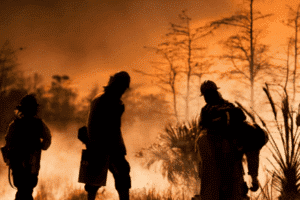
Here is a quick checklist of what to do if a bushfire approaches:
Always follow the directions of Fire Authorities who are in control while the fire event is underway.
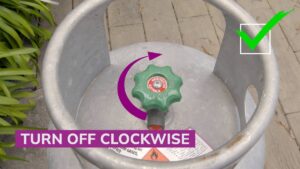
- Make sure the BBQ Gas bottle is turned off (clockwise) at the valve on top of the bottle.
- Detach the gas bottle from the BBQ.
Remember, it’s reverse thread so turn the knob clockwise to loosen and remove.
Ensure the gas bottle remains upright at all times. This enables the pressure relief valve to operate correctly to release pressure and minimise any chance of explosion. - Place the gas bottle away from any flammable materials, in a well ventilated area and clear of any ignition sources. If there is an ignition source nearby any venting gas may ignite.
- Once the bottle is removed from the BBQ. Make sure the Pressure Relief Valve is pointed well away from anything combustible. For reference, the Pressure Relief Valve points in the opposite direction from where you screw in your hose connection to the cylinder.
- Ensure that there are no gas bottles stored indoors or underneath the property.
We don’t recommend throwing gas bottles into a body of water.
After the event cylinders are often lost or forgotten becoming a hidden hazard.
Many people have been seriously injured or killed boating, water skiing, diving into water, using machinery, etc. when they hit obstacles they don’t expect to be there.
Cylinders can also float into positions where the effectiveness of their inbuilt safety features are compromised.
When you return home
- Ensure your BBQ cylinders are turned off.
- Do not use a BBQ cylinder that has been heat or fire damaged.
- Call ELGAS on 131 161 for assistance. Fire damaged cylinders can be returned to ELGAS for disposal.
Do not transport a leaking cylinder. Leave a leaking cylinder in an open space away from sources of ignition and call ELGAS Emergency on 1800 819 783.
NOTE: Always follow the directions of Fire Authorities who are in control while the fire event continues.
ELGAS will be able to act and assist only on the direction of Fire Authorities.
Gas Bottles Rarely Explode
First, don’t worry about the gas bottle exploding, as that would be quite unusual, as long as you keep the BBQ gas bottle upright.
This enables the Pressure Relief Valve to operate correctly.
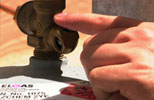 The Pressure Relief Valve is incorporated into the main gas valve on the bottle, as pointed to in the accompanying picture.
The Pressure Relief Valve is incorporated into the main gas valve on the bottle, as pointed to in the accompanying picture.
It’s actually a valve within a valve.
If the pressure of the gas inside the bottle increases, as the result of a fire or other heat source, the pressure relief valve releases some of the gas to relieve the pressure.
Aim it Safely
However, if the pressure does build up, gas will vent through the Pressure Relief Valve.
 If there is an ignition source nearby, the venting gas may ignite, creating a plume of flame.
If there is an ignition source nearby, the venting gas may ignite, creating a plume of flame.
The important thing is to make sure that the gas bottle is not near anything flammable and to aim the Pressure Relief Valve safely away from any combustible materials. (see image)
For reference, the Pressure Relief Valve points in the opposite direction from where you screw in your regulator.
The flame plume will self-extinguish when the pressure is relieved and the Pressure Relief Valve closes itself or when the gas bottle runs out of gas.
As long as it was safely positioned away from anything that burns, it should not create any additional problems, reducing the risk of an explosion.
Large Gas Bottles

Always follow the direction of the Fire Authorities who are in control while the fire event is underway.
If you have 45kg or larger home gas bottles or cylinders, this is what to do before the fire arrives or before evacuating:
- Turn it off (in clockwise direction) at valve on top of the bottle.
- Leave the bottle or cylinder where it has been installed.
- Leave the bottle or cylinder in an upright position.
- Ensure it is secured to a solid structure and on a solid base to prevent it falling over, with the Pressure Relief Valve vent facing away from building.
The vent is the protrusion, usually with a dust cover, that is opposite of where the gas line screws into the valve. - Remove any combustible materials surrounding the gas bottles.
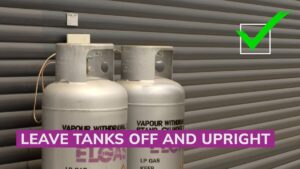
What NOT to do
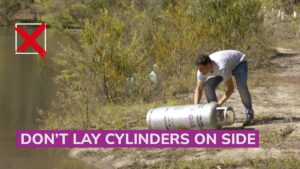
What NOT to do with an LPG gas cylinder before evacuating:
- Never move it inside a house or structure, as it can be a hazard to fire fighters.
- Never lay it on its side.
- Never cover it with wet material to it keep cool.
These materials may dry out and burn, heating the bottle/cylinder.
Post-Fire Actions for LPG Installations
These actions have been developed to assist with the safety of LPG installations that have been damaged or potentially damaged by fire, and for the safe return to service of this equipment.
Even if LPG vessels appear to be undamaged, there may be damage to components that is not apparent but can affect safe operation or cause leaks.
If in doubt call your local ELGAS on 131 161.
When you return home:
- Ensure all supply valves and appliances are turned off if safe to do so.
- Do not attempt to start any LPG appliance, or turn supply back on, until the installation is checked by a gasfitter.
- If your cylinders are heat or fire damaged ELGAS will replace them without cost.
- If cylinders have fallen or are upturned, do not attempt to move them, and contact ELGAS on 131 161.
- If you can hear or smell LPG:
- Turn cylinders off if safe to do so.
- Call ELGAS on 131 161 or a licensed gas fitter.
- Stay well clear of the installation and keep any sources of ignition away.
NOTE: Always follow the directions of Fire Authorities who are in control while the fire event continues.
ELGAS will be able to act and assist only on the direction of Fire Authorities.
New Residential LPG customer?
New Business LPG customer?
Existing ELGAS customer?
- BBQ – Gas and Charcoal BBQ Features – Charcoal BBQ vs Gas BBQ Comparison - March 31, 2025
- GPL Gas (GPL Fuel) – GLP Gas – LPG Gasul: GLP-GPL Gas Station - March 26, 2025
- Think LPG When Building a New Home - February 26, 2025
Steve Reynolds
Technical Consultant
Steve Reynolds is a leading expert in the LPG industry with over 22 years of experience. As part of the national management team at ELGAS, Steve ensures the safe and efficient storage, handling, and transportation of LPG. He serves as the lead investigator for incidents and collaborates with authorities on industry developments.
Steve is a technical advisor to Standards Australia and Gas Energy Australia (GEA), and an active member of the World LPG Association (WLPGA), contributing to global standards and technical reviews. He holds a BSc. (Hons) in Industrial Chemistry from UNSW and has held senior safety and technical roles at ELGAS, making him a trusted authority in LPG safety and standards.
